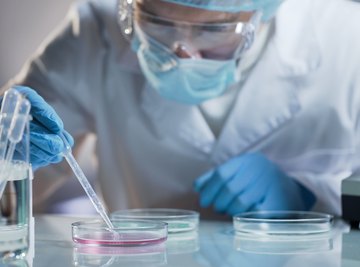
Organelles are small membrane-bound structures found in eukaryotic cells. They handle specialized functions that are either missing in or that are carried out throughout the cell in simpler single-cell organisms. Because they specialize in specific organelle functions inside their membranes, they can operate much more efficiently and in a more controlled manner than the simpler cells.
The types of organelles include those responsible for reproduction, waste disposal, energy production and synthesizing cell substances. The different kinds of organelles float in the cell cytoplasm in numbers that depend on the type of cell.
Some organelles contain their own genetic material so that they can multiply independently of cell division. This ensures the cell always has enough of each type of organelle for whatever the cell needs.
The Origin of Organelles
Many organelles act a lot like complete cells themselves. They have their own membranes, their own DNA and they can produce their own energy. They get what they need from the larger cell that surrounds them, and they provide the cell with a specific functionality that the cell otherwise would either not have or would have to carry out inefficiently.
Scientists believe that organelles such as the chloroplast and the mitochondria may originally have been separate, self-sufficient cells. When the evolution of life was at the single-cell stage, large cells may have engulfed smaller cells, or small cells may have entered large cells.
Instead of the large cells digesting the small cells, the small cells were allowed to stay because the arrangement was mutually beneficial. The small cells eventually evolved into today's organelles while the large cells organized themselves into complex organisms.
What Does the Cell Nucleus Do?
The nucleus is the command center for the cell. It contains most of the DNA, the genetic material that governs cell functions. It is surrounded by a double membrane that controls what passes in and out of the nucleus. In addition to DNA, the nucleus contains the nucleoli, small bodies that help with protein synthesis. The nuclear membrane is connected to another organelle, the endoplasmic reticulum.
The nuclear DNA controls protein synthesis in the cell by allowing the DNA to be copied by messenger RNA (mRNA). The mRNA can pass through the nuclear membrane and transfer the DNA instructions to ribosomes floating in the cell cytoplasm or attached to the endoplasmic reticulum. The ribosomes synthesize proteins needed by the cell according to the RNA instructions.
The nucleoli help produce ribosomes to replace defective ones and to add new ones as the cell grows. Ribosomal subunits are assembled in the nucleoli and then exported to the nucleus where additional processing is carried out. Finally the ribosome proteins travel through holes in the nuclear membrane to become complete ribosomes, either free-floating or ones that are attached to the endoplasmic reticulum.
Mitochondria Produce and Store the Cell's Energy
The mitochondria organelles are the cell's energy powerhouses. They break down the products of nutrients such as glucose into carbon dioxide and water while using up oxygen. They store the resulting energy in molecules of adenosine triphosphate (ATP). The energy stored there powers cell activities.
Mitochondria have a smooth outer membrane and a heavily folded inner membrane. The energy-creating reactions take place inside and across the inner membrane. A chemical cycle called the citric acid cycle produces electron donor chemicals for the next step in the reaction, called the electron transfer chain (ETC).
The ETC takes the donated electrons and uses their energy to produce ATP. The ATP molecules have three phosphate groups attached to the main body of the molecule. When a phosphate group is removed, breaking the bond releases chemical energy that the cell uses for other chemical reactions. The ATP molecules can pass through the mitochondrial membranes and travel to where the cell needs them.
Chloroplasts Change Sunlight Into Cell Nutrients
Green plants have chloroplasts for carrying out photosynthesis. The chloroplasts are plant organelles that contain chlorophyll. All other life forms depend on the nutrients that plants produce in their chloroplasts. For example, higher animals can't produce nutrients on their own, so they have to consume plants or other animals.
Chloroplasts are enclosed by a double membrane and filled with green stacks of flattened sacks called thylakoids. The chlorophyll is in the thylakoids, and this is where the chemical reactions of photosynthesis take place.
When light hits a thylakoid, it releases electrons that the chloroplast uses in a chain of reactions to synthesize starches and sugars such as glucose. The glucose in turn can be used for energy by the plants and by animals that eat them.
Lysosomes Act Like the Cell's Digestive System
The small membrane-bound organelles called lysosomes are full of digestive enzymes. They break down cell debris and parts of the cell that are no longer needed. The lysosomes engulf smaller particles and digest them, or the lysosomes may attach themselves to larger bodies. Lysosomes recycle the molecules they digest by returning substances with simple structures back to the cell for further use.
Lysosome enzymes work in the acidic interior of the organelle. If a lysosome leaks or breaks up, the acid from its interior is quickly neutralized, and the enzymes that rely on the acidic environment can no longer carry out their digestive function. This mechanism protects the cell because otherwise enzymes from a leaky lysosome could attack cell structures and components.
The Endoplasmic Reticulum Synthesizes Materials That the Cell Needs
The endoplasmic reticulum is a folded membrane attached to the outer membrane of the nucleus. The synthesis of carbohydrates, lipids and proteins takes place here. Ribosomes that produce proteins are attached to the rough endoplasmic reticulum and the proteins are sent back to the nucleus or the Golgi apparatus, or they are released into the cell.
Additional substances are synthesized by the smooth section of the endoplasmic reticulum membrane and transported to the parts of the cell where they are needed. Depending on the type of cell, the membrane produces material for the outer cell membrane or it may produce enzymes and hormones required for the cell functions.
The Golgi Apparatus
The Golgi apparatus, named after Italian scientist and discoverer Camillo Golgi, is made up of a stack of flattened sacks located near the endoplasmic reticulum and the nucleus. It is responsible for additional processing of proteins and sending them to the organelles that need them or out of the cell. It gets most of its input materials from the endoplasmic reticulum.
Proteins and lipids enter the Golgi apparatus at the stack end closest to the nucleus. As the substances migrate through the different sacks, the Golgi body can add to and modify the chemical structure of the molecules. The processed materials exit the Golgi apparatus at the other end of the stack.
How Different Types of Organelles Support Cell Functions
While cells are the smallest unit of life, many organelles are independent with functions that help give the cell its characteristics. The different kinds of organelles are important parts of a cell, but they can't exist by themselves. Even if some of them were once self-sufficient cells, they have evolved into an integrated part of the larger cell and the corresponding organism.
By concentrating cell functions such as energy production and waste disposal in a designated space, they make the cell more efficient and make it possible for cells to organize themselves into complex multicellular creatures.
References
About the Author
Bert Markgraf is a freelance writer with a strong science and engineering background. He has written for scientific publications such as the HVDC Newsletter and the Energy and Automation Journal. Online he has written extensively on science-related topics in math, physics, chemistry and biology and has been published on sites such as Digital Landing and Reference.com He holds a Bachelor of Science degree from McGill University.
